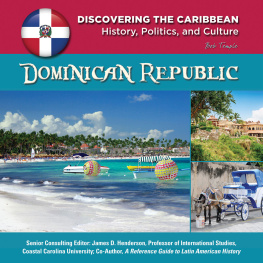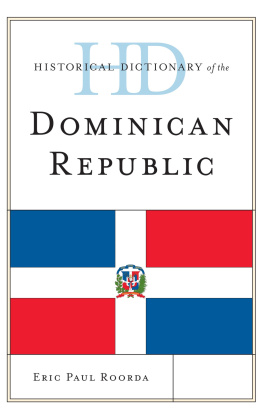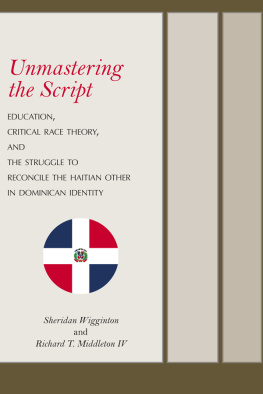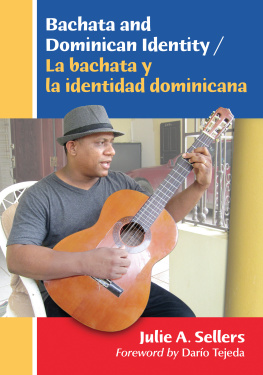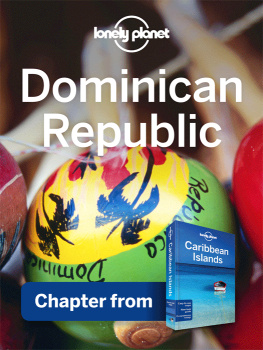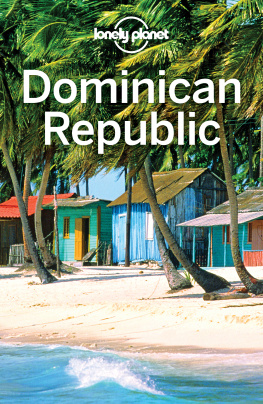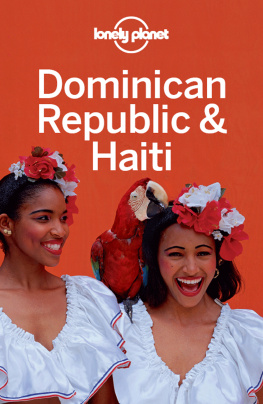Publication of this book was supported in part by funding from the University of Houstons Womens, Gender & Sexuality Studies Program and the UH Friends of Womens Studies.
2021 by the Board of Trustees of the University of Illinois
All rights reserved
Library of Congress Cataloging-in-Publication Data
Names: Quinn, Rachel Afi, author.
Title: Being la Dominicana : race and identity in the visual culture of Santo Domingo / Rachel Afi Quinn.
Description: Urbana : University of Illinois Press, [2021] | Series: Dissident feminisms | Includes bibliographical references and index.
Identifiers: LCCN 2021010536 (print) | LCCN 2021010537 (ebook) | ISBN 9780252043819 (hardcover) | ISBN 9780252085802 (paperback) | ISBN 9780252052712 (ebook)
Subjects: LCSH: WomenDominican Republic. | FeminismDominican Republic. | Dominicans (Dominican Republic)Race identity.
Classification: LCC HQ1514 .Q85 2021 (print) | LCC HQ1514 (ebook) | DDC 305.4097293 dc23
LC record available at https://lccn.loc.gov/2021010536
LC ebook record available at https://lccn.loc.gov/2021010537
Acknowledgments
When I first visited my father in Ghana at age seventeen, his mother, Sarah Doe Kpetigo Glover (Nano), gave me the Ewe name Ametolesi, meaning roughly many people stand behind you. This could not be more true! I have marveled at my good fortune to have such wealth of loved ones near and far. This book is based on research from a decade and a half of travel to the Dominican Republic and time spent living there. Many transnational communities have sustained me over the years, and I recognize how all of them have had some influence on me as I crafted this book. As someone who thrives on the energy and inspiration of others, over the last decade I have had the opportunity to connect with more people who have helped make this book a reality than I can possibly remember and name herebut I will give it a try.
Thank you to the numerous scholars I had the pleasure of working closely with at University of Michigan while in the Program in American Culture: Evelyn Azeeza Alsultany, who deftly guided me through my graduate studies; Mara Cotera, Jesse Hoffnung-Garskof, and Lori Brooks, who each in their own way helped me find my way with a first iteration of this project; many thanks to Nadine Naber, Ruth Behar, and Magdalena Zabarowska in this regard as well. I am particularly appreciative of the ever-thoughtful mentorship and steady calm of Tiya Miles. Thank you also to Brandi Hughes, who made sure I would find somewhere to land. The solidarity of so many sustained me throughout graduate school: special thanks to Patricia Moonsammy, Afia Ofori-Mensah, Roxana Galusca, Laura Wernick, Kanika Harris, and Vanessa Daz, with a big a shout-out to Shana Weaver.
I would not have been prepared to do this project, or had a way to approach the work without the training I received for just two weeks at Cornell as part of the Future of Minority Studies (FMS) summer institute led by Chandra Talpade Mohanty and Beverly Guy-Sheftall in 2009. The FMS community has been foundational to my work as a transnational feminist scholar and the relationships forged there have inspired and fortified me on this long journey. I am thankful to have found peer mentorship and friendship with Sylvanna Falcn, Tania Triana, Azza Basarudin, Sharmila Lodhia, Michelle Telles, Shareen Roshanravan, Edwin Hill, Moya Bailey, Arica Coleman and many other dear FMSers. I have also been fortunate to join the fold of the National Women Studies Association (NWSA), which has offered beloved community. The NWSAs Transnational Feminisms caucusborn out of the Thinking Transnational Feminisms summer institute at Ohio State University of which I was fortunate to be a partcontinues to inspire my work. Funding for this project began with the University of Michigans Global Transformations Fellowship that got me to the Dominican Republic for the first time. Since, the University of Houston has been a tremendous supporter of this research over the years. I was able to complete this project through the gift of time and intellectual community provided by a Woodrow Wilson Career Enhancement Fellowship, while comradery and funding from the UH Under-represented Women of Color Coalition helped get me to the finish linewith special thanks to Erika Henderson and Andrea Georgsson for investing in my success.
Of course, this book is only possible thanks to the generosity of strangers willing to share with me about their livesand translate the details. Many brilliant and talented friends in Santo Domingo contributed to my understanding of and love for the Dominican Republic over the years. Most especially, I am thankful for the friendship and generosity of Yaneris Gonzlez Gmez, Diana Prez, Nathaly Ramos, Alejandra Prido, Michelle Ricardo, Dulcina Abreu, Xiomara Fortuna, Isabel Spencer, Aurora Martnez, Glaem Parls, Marcos Morales, Laura Bretn Despredal, Jeannette Tineo Durn, as well as Princess Jimnez, Merlyn Cornelio, Inda George, and numerous other kind souls who are not named in my work. I truly would not know the Dominican Republic the way I do without my longstanding relationship with la familia Garca, in particular Marta, Mercedes, Criselda, Patricia, and la doa Merida Reynosa de Garca (Palina), and all that I have learned from their health clinic FUVICREF serving women and girls in their hometown of Sabana Grande de Boy. In my neighborhood of Los Jardines del Norte, I was welcomed by Suni Rosario Batista and her children Liberman, Darlyng, Carlos, Jerilee, and Ana Celia, and their extended family. It has also been a pleasure to know Nairobi Acosta and Edwin Prez and their daughter, Genesis, since she was very small. I am also lucky to have overlapped in my time in Santo Domingo with Erika Martnezwho taught me much about the processes of writing and friendshipand friends Meg Hendrickson and Roberto Obando, Sarah Adler-Milstein, and Julio Gonzalez Ruz. Julios passion for life, and for the Dominican Republic, will remain an inspiration to all of us who knew him. Much gratitude goes to my humble friend Luca Mendez Rivas for sharing her beautiful artwork for the cover image and to photographers Lorena Espinoza Pea and Fran Afonso, along with Penelope Callado and Cindy Galn. Ana Francisca Acevedo has been a patient and enthusiastic friend and language teacher over the years and was critical to my research success, as was Lisa Borchetta in the early stages of this project. I am also grateful to Tertlia Feminista Magaly Pineda under the leadership of Esther Hernndez-Medina and Yildalina Tatem Brache and all who have welcomed me into that space. Many more scholars and activists whom I have encountered in Santo Domingo have kindly encouraged me in this journey, namely Quisqueya Lora, Frank Moya Pons, Sergia Galvn Ortega, and the late Magaly Pineda and Tony de Moya. I have felt fortunate to join a tremendous network of Dominican studies scholars, who have supported my intellectual growth and trusted in my work, in particular Lorgia Garca Pea, Raj Chetty, Maja Horn, April Mayes, Elizabeth Manley, Sharina Mailla-Pozo, Zaida Coroniel, and Jacqueline Jimnez Polanco.


